Vive Cosmos Review
Is the high-resolution display enough to justify the Cosmos' steep price?
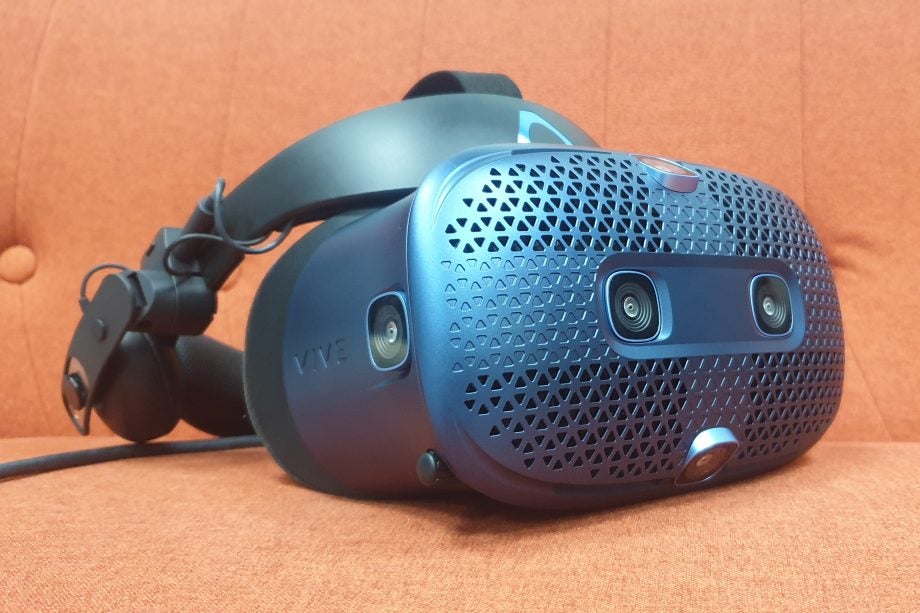
Verdict
The Vive Cosmos is a solid, but pricey, headset for VR enthusiasts happy to sacrifice convenience for a high-resolution display. For everyone else, though, the Oculus Quest looks like the better-value VR buy.
Pros
- Inside-out tracking makes setup quicker and easier
- Super-high resolution display
- Comfy and stylish design
Cons
- Far too expensive
- Wired tether ruins immersion
- Inside-out tracking only works in bright rooms
Key Specifications
- Review Price: £699
- Release date: 3 October 2019
- Requires a powerful gaming PC
- 2880 x 1700 combined resolution
- Field of view: Maximum 110 degrees
- 6 cameras for inside-out tracking
What is the Vive Cosmos?
The Vive Cosmos is the latest virtual reality headset from HTC, boasting multiple improvements over the original HTC Vive that launched back in 2016.
The most notable difference with the Cosmos is that it no longer requires external sensors. Instead, the headset’s six integrated cameras take care of all the tracking with 310 degrees field of view, reducing the hassle of setup drastically.
The second-best improvement is the resolution, boosting the combined pixel count from 2160 x 1200 up to an impressive 2880 x 1700 in order to finally put an end to the screen door effect prevalent in VR experiences. The design has also received a makeover, with integrated headphones and a far more comfortable fit improving the overall experience.
But while the Cosmos is a clear upgrade over the original Vive, there perhaps aren’t quite enough upgrades for it to be a better buy than the Oculus Quest and Oculus Rift S, especially at the Cosmo’s steep £699 launch price.
Related: Best VR headset
Design
The Vive Cosmos is possibly the best-looking VR headset available. That’s probably one of the least important aspects about a gadget you strap onto your face, but at least it will look pretty sitting on your shelf when not in use.
The shiny blue plastic casing stands out from the simplistic black Oculus headsets, especially with the grille providing some quirky flair. And while Oculus attempted to keep its front-facing cameras subtle, Vive has purposefully drawn attention to them with the Cosmos via massive lenses that help portray edgy sci-fi styling.
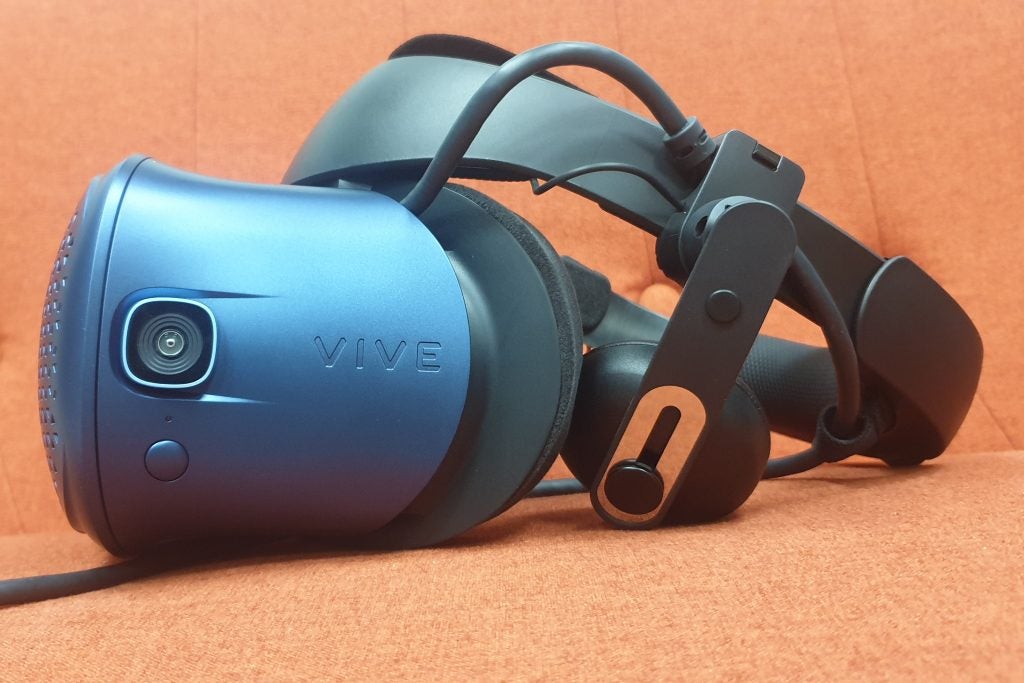
More importantly, the Cosmos is significantly more comfortable than its predecessor. Gone are the days where you’re forced to wear a mesh of Velcro to keep the headset strapped on. The Cosmos has a solid plastic halo ring to better support your head and prevent it applying pressure to your neck and forehead. There’s also oodles of padding to keep it feeling cosy on your noggin.
Putting the headset on is dead-easy now that there’s only one Velcro strap to contend with. An adjustment wheel – one of the best design features of the Vive Pro – also features to easily alter the fit of the device for heads of various shapes and sizes.
Another excellent addition borrowed from the Vive Pro is the integrated audio. You don’t need your own buds since headphones are built into the Cosmos. The sound is perfectly adequate for gaming soundtracks – although, bizarrely, there’s no volume wheel on the headset itself.
The headphones themselves are a little fidgety, as you have to push them close to your ears to lock them into place. However, the benefit of this is that you don’t get quite the audio leak you do with the Oculus Quest, which can be irritating for anyone else in the room.
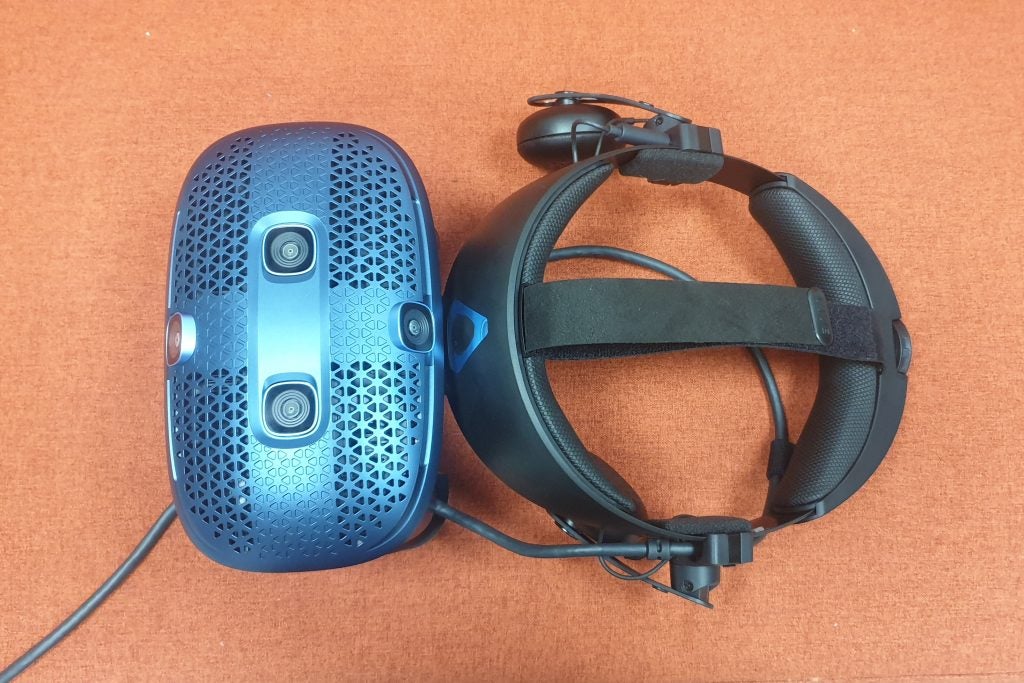
The Vive Cosmos also has a hidden hinge that allows you to flip the headset up off your face. This allows you to see your surroundings without needing to unstrap the whole unit. This is really handy if you want to quickly check your smartphone in-between Beat Saber sessions, or simply to get a blast of fresh air once you’re starting to get sweaty.
The final special design feature of the Cosmos is its modular face plate. There’s only one mod available on day one, which allows users to hook up the Cosmos to their existing Lighthouse base stations and previous-generation peripherals such as the Vive Tracker. HTC will no doubt reveal more mods in the future, widening the scope of potential for the headset beyond launch.
Related: Best gaming CPU
Controllers
- The magic touch
HTC has ditched its original motion controller design for the Cosmos, opting instead for something that looks suspiciously similar to the Oculus Touch controllers. It might be a blatant copycat design, but it’s still a good move for the Vive Cosmos.
The new Cosmos controllers are better suited to replicating hand movement. Holding down all three triggers simulates fingers folding into a fist, which makes it far easier for newcomers to understand how to pick up an object or pull a bow string.
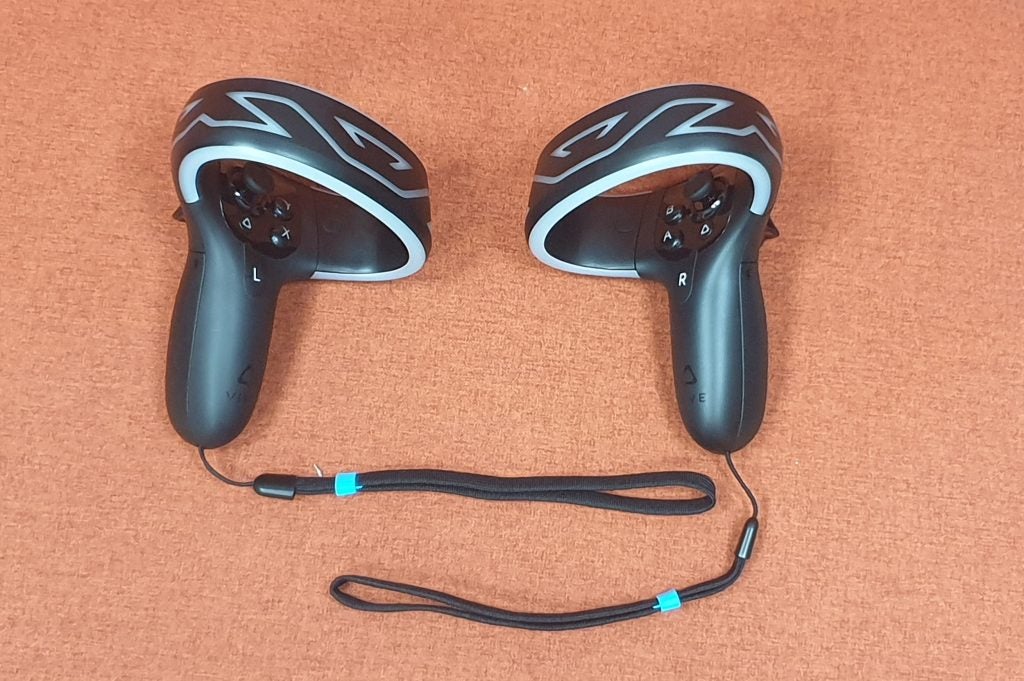
A bonus plus point of the two major virtual reality headsets now sharing a similar control scheme is that it should make it easier for game developers to streamline inputs across multiple platforms.
However, the major issue with this design change is that games currently downloaded from Viveport and Steam VR still assume you’re using the old controllers, which makes tutorials and guides confusing. This is something that should easily be fixed with a software update, but I’m still somewhat concerned this hasn’t been amended so close to launch.
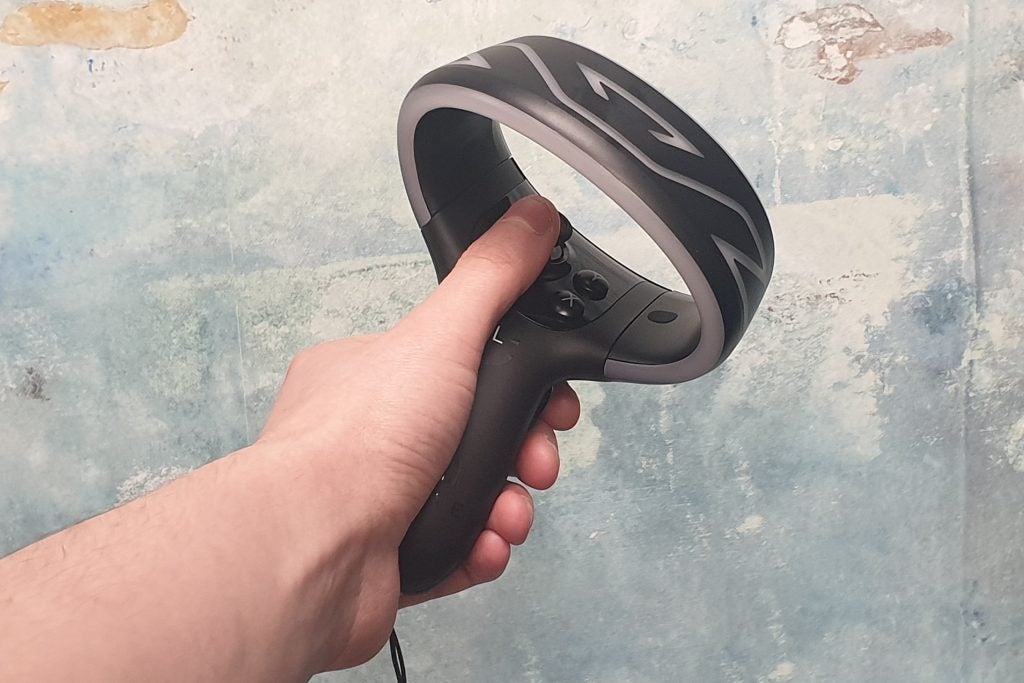
The Cosmos controllers have a funky pattern running around the circumference of the rings. This acts as a great indicator of the controller’s status, with faded pulsing light signifying it’s syncing and a solid white glow showing it’s ready for gaming.
Frustratingly, each Cosmos controller requires two AA batteries to function. You do get four bundled in the box, so you don’t need to go digging into your battery drawer straight away, but I still don’t understand HTC’s refusal to consider rechargeable controllers.
Specifications
- High-fidelity gaming
Judge the Vive Cosmos and Oculus Rift S purely by the spec sheets and the former is the undisputed champion. The 2880 x 1700 combined resolution of the Cosmos easily beats the Oculus Rift S 2560 x 1440 pixel count and absolutely trounces the Quest’s 1440 x 1600 offering.
In use this gives the Vive Cosmos superior visual fidelity, with images appearing sharper and the screen door effect seemingly eliminated. A 90Hz refresh rate also helps to make fast movement appear smoother than it is via the Rift S, which is lumbered with a slightly slower 80Hz LCD panel. This visual upgrade helps to improve in-game immersion and is easily the biggest strength of the Cosmos over the Rift S.
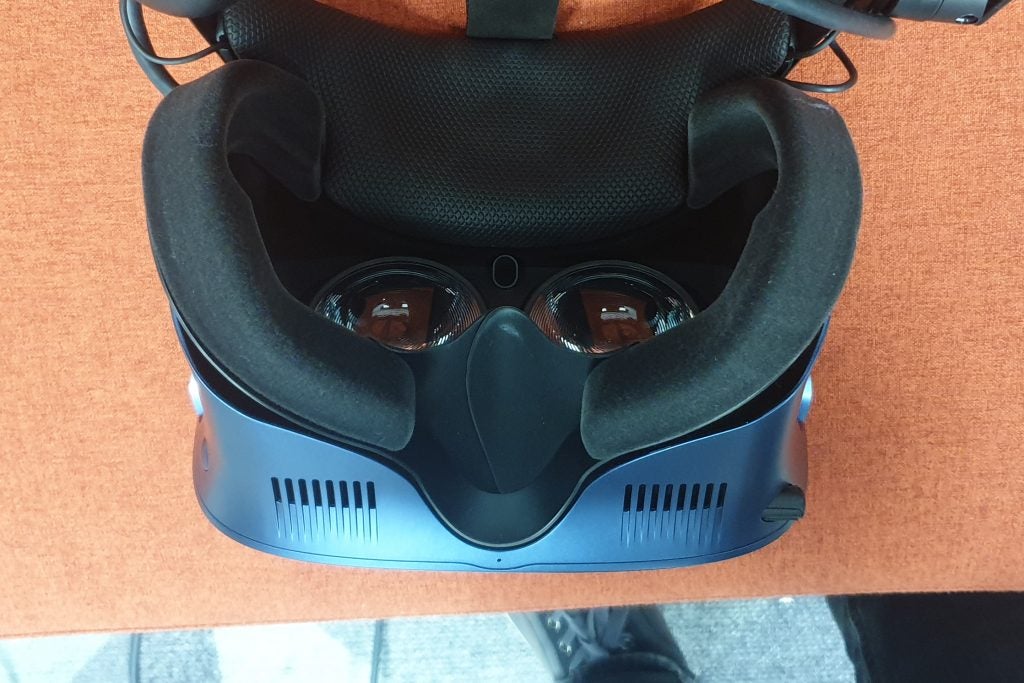
The Vive Cosmos also has one extra tracking camera compared to the Oculus Rift S, which should theoretically mean better tracking performance, right? The tracking accuracy of the Cosmos is admittedly great, but only in rooms with bright light.
When attempting to use the Cosmos in my bedroom or the Trusted Reviews test room, the Cosmos outright refused to function – or suffered a terribly laggy performance, with pop-up alerts claiming there wasn’t enough light for the cameras to accurately track my movement.
Admittedly, both rooms are dimly lit, but not beyond what you’d usually find in households after dark. The Oculus Quest suffered no such problem in the exact same conditions – even when playing the ultra-speedy Beat Saber – so HTC can’t claim this is the norm with inside-out tracking technology.
The good news is HTC is aware of the issue, and sent me the following message: “Our engineering team continues to fine-tune performance of the headset for all play environments and we are looking into these reports.”
The headset’s need for an intensively bright room is currently a major flaw for the Vive Cosmos. Couple this with the minimum space requirements of 2m x 1.5m for room-scale mode and it becomes increasingly difficult to find an adequate room in which to play VR. The inside-out tracking technology was supposed to make setup more convenient, but it has arguably achieved the opposite.
You don’t have to play room-scale, of course. If you lack the space, or simply don’t want to be flinging yourself around the room, the Cosmos accommodates standing and sitting play with select titles, too.
The Vive Cosmos requires a separate gaming computer (with at least a Nvidia GTX 1060 or AMD Radeon RX 480 graphics card) to function. What’s worse, you’ll have to be linked up to the computer via cable, which is an absolute nuisance for tripping you up mid-game. You can buy the Vive Wireless Adapter to solve this problem, but you’ll need to spend an additional £299 for the luxury. After playing with the Quest cable-free for the past few months, it feels like a major step backwards.
Related: Best graphics card 2019
Games
- Stick to the classics
Since the Vive Cosmos plugs into your gaming PC, you get access to a massive library of VR games, both via SteamVR and Viveport.
I did encounter a handful of games, including the cutesy VR adventure Moss, which are currently incompatible with the Cosmos. I reached out to HTC for clarification on this and they responded with the following statement: “For titles that are not optimized for Cosmos or Cosmos controls, they will be temporary disabled until they are updated.” It’s reassuring that these games will eventually run on the Cosmos following updates.
There are still plenty of games to play though, with HTC claiming “90% of Viveport’s top 100 titles are compatible as well as 30 of Steam’s top 50 VR title”. My favourite picks are Beat Saber, Superhot VR and Thumper, which are absolutely fantastic experiences I can’t recommend enough.
There’s an issue, though: these three titles actually run on the Oculus Quest without needing to be tethered up to a gaming PC. It’s only large-scale titles such as Skyrim VR and Doom VFR that actually require a gaming PC; personally, I’m not a huge fan of these experiences anyway, since they generally don’t feel well suited to VR controls.

Of course, while the Quest is capable of running the likes of Thumper, it’s a far better experience when using the Vive Cosmos thanks to the superior visual fidelity. The surreal worlds you inhabit look far sharper and immersive when viewed through the Cosmos goggles. Whether that improvement is worth the extra £300 is another story altogether.
Another advantage of opting for the Cosmos is the free six-month subscription to Viveport, where you get unlimited access to a number of games. Unfortunately, there aren’t many big-hitter titles included in this service. It says a lot when one of my favourite VR games from this library was a VR re-imagining of Angry Birds.
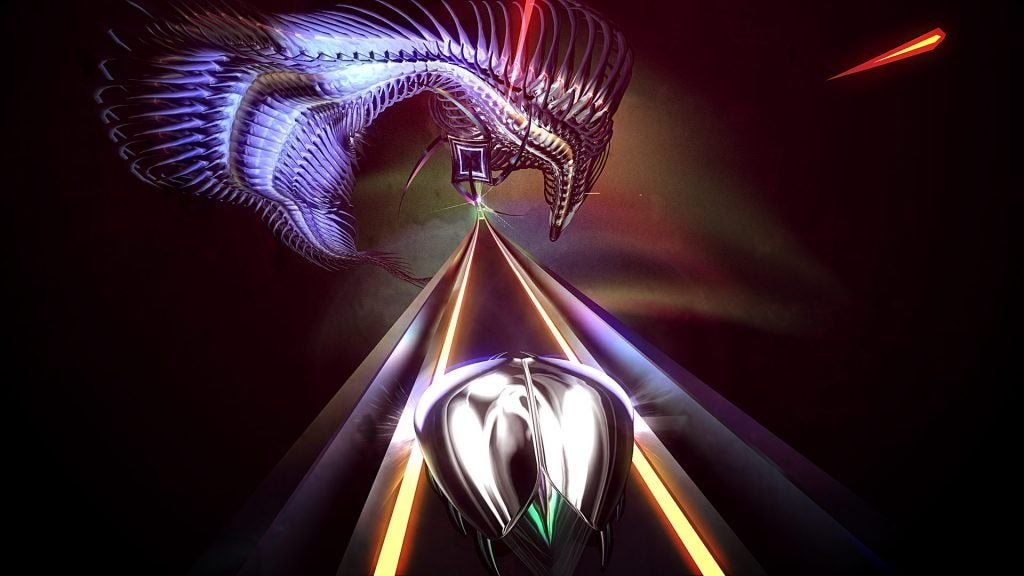
There were a couple of Viveport titles worth checking out, including rhythm shooter Audica, but I couldn’t help but think I’d rather be playing Beat Saber instead. That became a reoccurring pattern, with the Viveport’s offering paling in comparison to games outside the subscription service. I really don’t think the service is worth paying a monthly fee for beyond the free trial.
I’m also not keen on how HTC has separated Viveport from SteamVR, rather than integrating the two together. Switching between the two platforms to access different games can be a faff. The Lens feature helps to make it a little easier by allowing you to open up your games library via a portal whenever you fancy, but opening up SteamVR to purchase and download a new game isn’t so simple whilst wearing the headset.
Related: Oculus Quest review
Should I buy the Vive Cosmos?
HTC clearly isn’t targeting curious VR newcomers or mainstream audiences with the Vive Cosmos. The steep £699 price and the need for a gaming PC gives it niche appeal, especially when the Oculus Rift S and Oculus Quest are £300 cheaper.
The Vive Cosmos does have a unique system selling feature, though: the high resolution. Games and experiences definitely look far sharper and immersive with the Cosmos compared to rival headsets. That won’t make a major difference for games with simplistic aesthetics, such as Superhot VR, but you’ll see dramatic improvements for Skyrim and Doom VFR. The infamous screen door effect is also barely noticeable when gaming with the Cosmos.
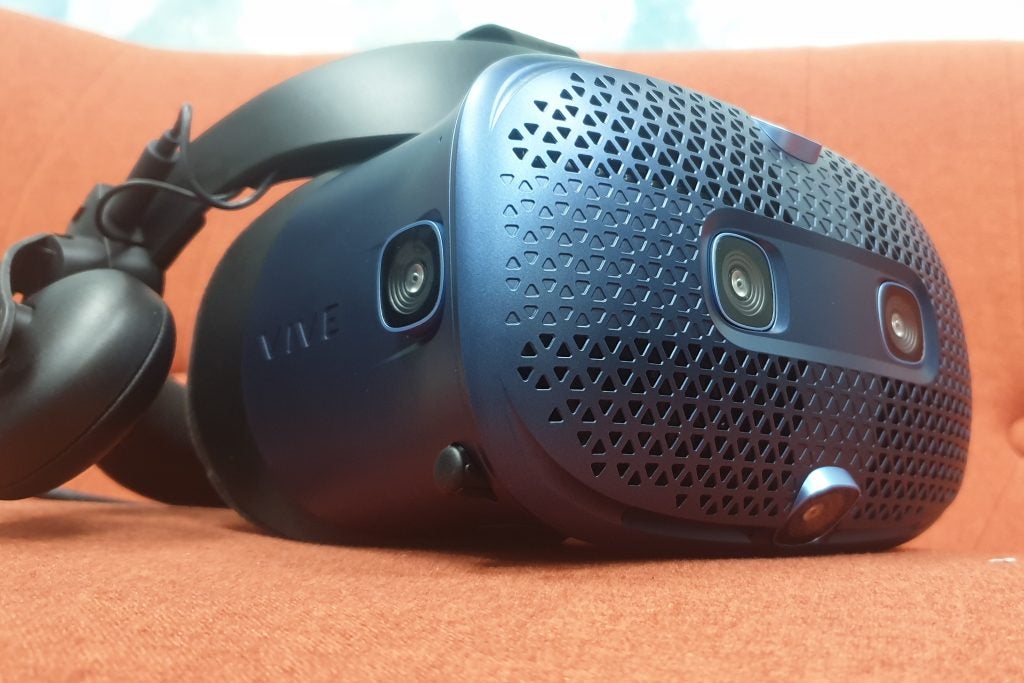
The inside-out tracking also makes the Cosmos headset a big upgrade on the original Vive and Vive Pro, although I did find the sensors to be frustratingly fussy with the lighting conditions of a room. Make sure you have a brightly lit room large enough to host your VR antics before purchase; otherwise, you’re going to bd seriously disappointed by the performance.
All that said, I still can’t help but think that the Oculus Quest is the better buy for most. Having the Vive Cosmos restricted to a tether (unless you buy the pricey Wireless Adapter) feels like a huge step backwards for VR, and I’m not convinced the higher visual fidelity is worth such an immersion-shattering compromise. And with Oculus recently announcing further new Quest features such as hand tracking, the Cosmos strangely feels outdated already.


